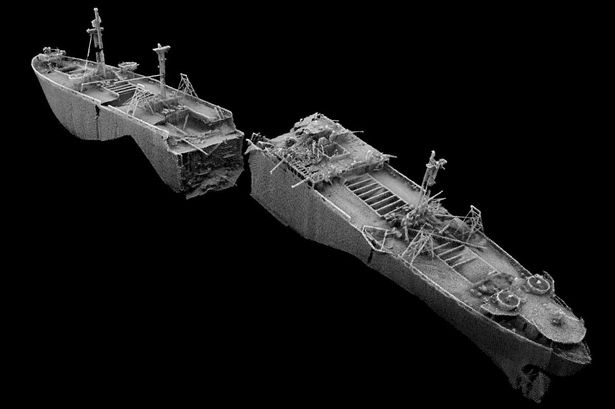A new image has been taken of the World War II vessel using multi-beam sonar technology, which captures the wreck in detail for the first time.

This incredible image shows the wreck of a World War Two ship laden with more than 1000 tonnes of explosives sitting at the bottom of the sea just off the Kent coast - and could detonate at any moment.
The SS Richard Montgomery sank in 1944 while carrying munitions, mostly aircraft bombs, with a total explosive content of 1,400 tonnes.
The bombs include dozens of 'high explosive Blockbuster bombs' and around 2,000 cases of cluster bombs, along with hundreds of 'normal bombs' weighing up to 1,000lbs each.

The Liberty ship was bound for France when it sank in 50ft of water in the Thames Estuary off Sheerness in Kent.
In 2004 New Scientist reported that if the ship exploded it would be one of the biggest non-nuclear blasts ever - and would devastate the nearby port of Sheerness.
Now, using the latest in multibeam sonar technology, this image of the American war ship has been released by the Maritime and Coastguard Agency (MCA), which shows the huge vessel in two parts.
The amazing 3D image of the vessel is the most high-resolution one ever released of the ship, which shows the true extent of the damage.
In the image, you can see the huge cargo including the ships anti-aircraft gun positions and broken beams. The incredible photo even gives a glimpse of the inside of the war ship - where it was likely the bombs would have been kept.
The SS Montgomery was one of over 2,500 vessels produced by the St John's River Shipbuilding company in 1943 to carry vital supplies across the Atlantic to Britain to help the war effort against Germany.
It was part of a convoy travelling to the UK in August 1944 and then onto Cherboug in France, but when it arrived in the Thames Estuary, it was instructed to anchor in the Great Nore, off Sheerness, Kent.
The vessel dragged her anchor in shallow water and was grounded on a sandbank, just 250 metres of the Medway Approach Channel.
Half of the cargo was removed before a crack, which has now torn the ship in two, developed in the hull.
It was then left to sink and it has remained on the sandbank for the past 71 years.
The MCA now spends up to £40,000 a year monitoring the ship, which is classified as a dangerous wreck under the Protection of Wrecks Act 1973.
Warning signs are attacked to the masts of the ships, which can be seen above the water line. The signs state 'Danger - Unexploded Ammunition. 'Do Not Approach or Board This Wreck'.

It is protected by a 500m (1,640ft) exclusion zone. In a new report into the condition of the rusting wreck released by the MCA this year, they said the risk of an explosion was 'low' and they will continue to monitor the vessel.
A spokeswoman for the Maritime and Coastguard Agency said:
"The image of the SS Richard Montgomery is generated from multibeam sonar data of the wreck structure beneath the water and laser data for the wreck structure which is visible above the water. These two datasets are then merged to create geo-referenced, measurable 3D images of the wreck in its entirety."
"The Maritime and Coastguard Agency have used multibeam and laser technology to survey the SS Richard Montgomery for a number of years."
"With advances in technology and data processing software, data quality has improved and, as a result, we tend to see greater definition and detail in the images which allows us to get a better picture of the wreck and its current state."
Source: www.mirror.co.uk